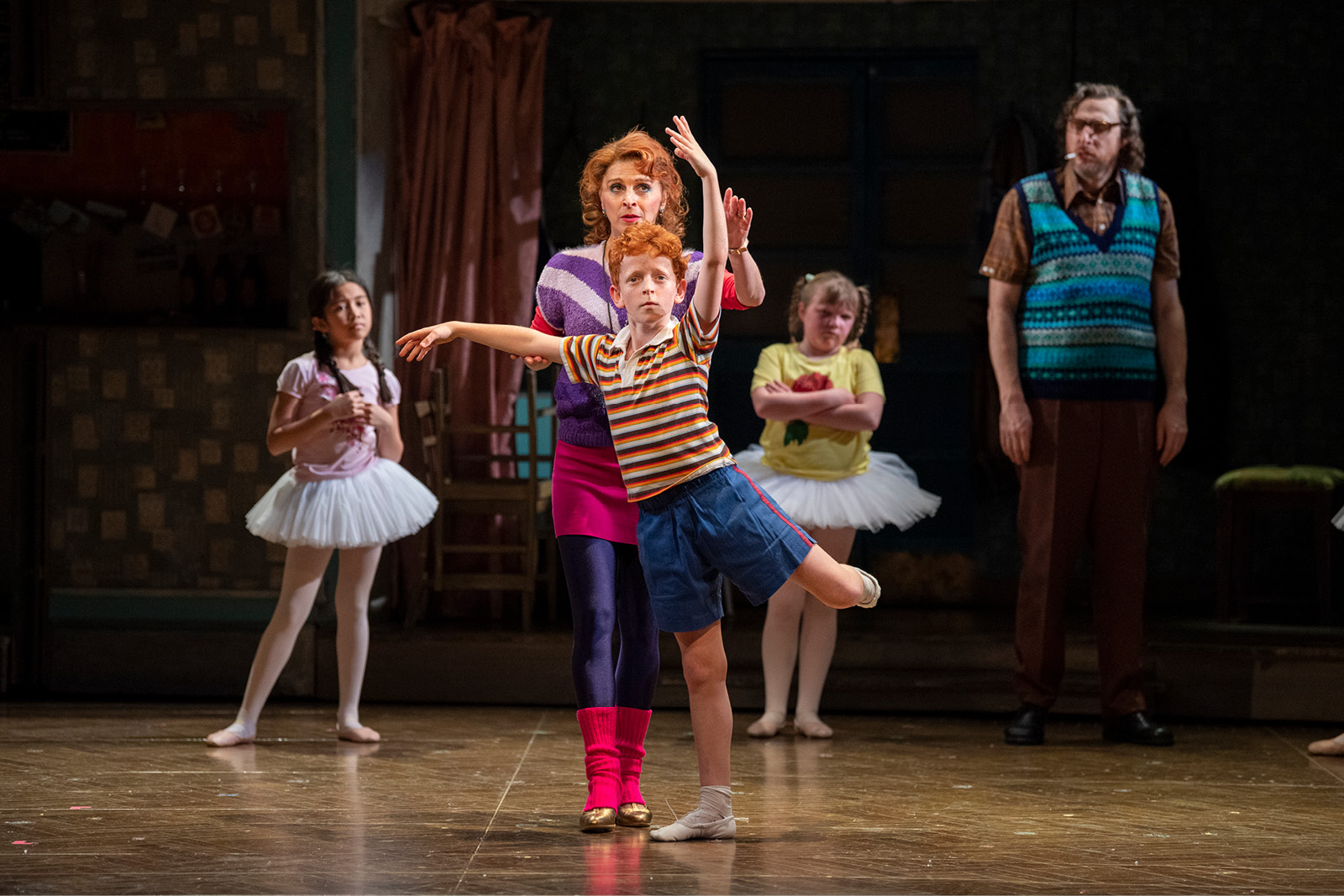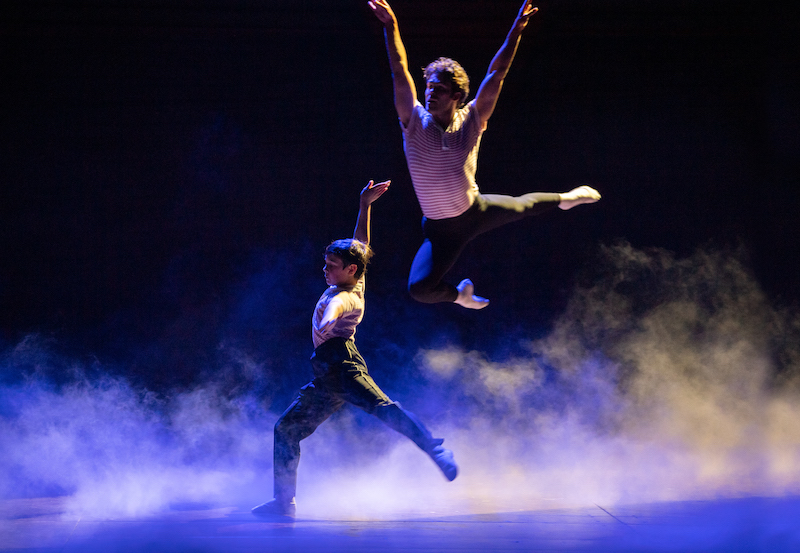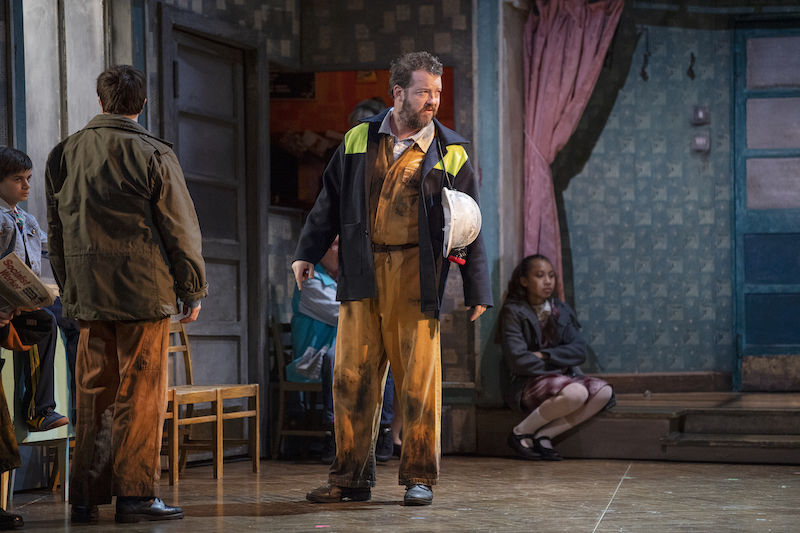Grainy black and white newsreel celebrates the nationalisation of the British coal industry. The footage then moves to Margaret Thatcher spruiking her “expenditure policy”, which saw her conservative government tackling the power of the unions and ruthlessly widening inequality in Britain. Later the ‘Iron Lady’ would famously say “there is no such thing as society”.
The news footage sets the scene for Billy Elliot The Musical, which is located in the north-east of England during the bitter miner’s strike of 1984 – 85. Based on the hit 2000 film, written by Lee Hall and directed by Stephen Daldry, the musical – which was also directed by Daldry, and features book and lyrics by Hall with music by Elton John – tells the story of a 12-year old miner’s son who stumbles across a ballet class when he is supposed to be learning boxing, and dares to dream of becoming a professional ballet dancer despite financial hardship and the outright refusal of his disgusted father and brother.
 Kelley Abbey and Jamie Rogers in Billy Elliot The Musical. Photograph © James M. Morgan
Kelley Abbey and Jamie Rogers in Billy Elliot The Musical. Photograph © James M. Morgan
While Billy’s dance teacher Mrs Wilkinson hopes for a better future for him, having recognised his talent, the working-class community in which they both live is in crisis as pit closures threaten the life of the town. Solidarity and community clash with the need for individuality, difference and tolerance.
Billy Elliot premiered in London’s West End in 2005. It was first staged in Australia in 2007 where it toured until 2009, and now returns for a 10th anniversary Australian tour.
It’s an extraordinarily powerful show, both politically and personally. Lee Hall and Elton John have done a brilliant job of maintaining the raw, gritty realism of the world in which the action takes place, pulling no punches in dramatising the hostility between the police and the miners, as well as the miners’ loathing of Thatcher and their scathing resentment of scab labourers. At the same time, it includes moments of exhilarating escapism and showbiz flashiness in numbers about self-expression from Billy himself and his cross-dressing friend Michael.
The production also draws on British political theatre traditions, notably Joan Littlewood’s influential, experimental theatre, and uses grotesque Thatcher puppets at a Christmas party in the local hall. As a result, the show feels authentically dark but is also very funny, exuberantly potty-mouthed (expect loads of swearing), uplifting, and deeply touching.
The musical has been superbly served by Daldry, set designer Ian MacNeil, costume designer Nicky Gillibrand and lighting designer Rick Fisher. Daldry’s intelligent, taut, robust direction keeps the action moving seamlessly and the dramatic tension high, while Peter Darling’s choreography is also crucial in telling the narrative, with some of the most powerful moments expressed through the inventive movement.
John’s music has just the right popular feel and simple emotional power, moving from lyrical ballads to tough, ballsy numbers that pulse with aggression and anger.
 River Mardesic and Aaron Smyth as the younger and older Billy Elliot in Billy Elliot The Musical. Photograph James D. Morgan
River Mardesic and Aaron Smyth as the younger and older Billy Elliot in Billy Elliot The Musical. Photograph James D. Morgan
One memorable scene follows another. Early on the miners and police face off against each other, while the children in Mrs Wilkinson’s dance class move between them – encapsulating the way everyone in the community is caught up in the conflict. Initially the police are mocked in a routine with a comic Keystone Kops influence, but later, as the strike drags on, they become far more brutal, lined up behind dehumanising riot shields. Act I closes with a ferocious energy as Billy lets rip in a furious tap solo, expressing his anger and frustration when his father refuses to let him audition for the Royal Ballet School. There’s a moving scene, when Billy dances with his older self, and try not to cry in the number Electricity in which Billy tries to express what he feels when he dances before bursting into dancing flight…
Though the musical is less sentimental than the film, it unashamedly pushes emotional buttons. But it does it with such truthfulness that I had tears flowing more than once, including when Billy and Mrs Wilkinson read a letter from Billy’s dead mother.
The cast of the current production does great justice to the show. The children play a large, vital role. Jamie Rogers, who played Billy on opening night (one of four boys who will share the role) brings a wonderfully down-to-earth quality to the character, capturing the tough bravado that Billy has had to develop, while deftly conveying his emotions and his longing for his mother. When he hugs Mrs Wilkinson your heart melts. He also dances extremely well.
Kelley Abbey is a knockout as the hard-bitten, terse Mrs Wilkinson, who is perpetually clad in tacky, colourful outfits, with a cigarette in hand. As a former dancer herself, and a choreographer, she is a perfect fit for the role, and nails the character’s tough exterior, standing her ground no matter who confronts her. While revealing little emotion, she lets us glimpse the warmth buried within, and her genuine hope that Billy will find a new life.
 Justin Smith in Billy Elliot The Musical. Photograph © James D. Morgan
Justin Smith in Billy Elliot The Musical. Photograph © James D. Morgan
Justin Smith, who played Billy’s brother in the original Australian production, now plays his father and does a stunning job, bringing a depth of complex emotion to the character, allowing us to see his gradual thawing regarding Billy’s (initially inexplicable) aspiration. When he sings a song at the Christmas party in memory of his wife, it’s heartbreaking, and he is touchingly sweet when he takes Billy to his longed-for audition and finds himself totally out of his depth in a world he knows nothing about.
Drew Livingston is very convincing as Billy’s bitter brother Tony, who fights to the last for the miners’ cause, Vivien Davies is wonderfully daffy as Billy’s straight-talking grandma who is experiencing early dementia, while Dean Vince as Mrs Wilkinson’s pianist Mr Braithwaite, and Robert Grubb as the boxing teacher George are both very funny.
Among the other children performing on opening night, Gabrielle Daggar exudes oodles of droll humour as Mrs Wilkinson’s daughter Debbie, while James Sonnemann is a delight as Michael. The ensemble, meanwhile, is terrific across the board.
Billy Elliot feels as timely as ever – and not just because of comments like those of Good Morning America host Lara Spencer who, in August, poked fun at Prince George for learning ballet at school (and who – hearteningly – was met with rebukes from around the world, including hundreds of male dancers performing together in Times Square). The show also rings true at a time where inequity is growing in Australia and people on welfare are treated as collateral damage. And though there is, of course, a push to close coal mines in the face of a climate change crisis, it’s all about treating the workers equitably and with humanity, and finding them new jobs.
It’s a beautiful musical full of complicated human emotion; a show with a serious political message but one that is joyously uplifting and entertaining at the same time.
Billy Elliot The Musical is currently playing at Sydney Lyric Theatre until December 15 2019, followed by seasons at the Festival Theatre, Adelaide Festival Centre from December 2019, the Regent Theatre, Melbourne from February 2020, Crown Theatre Perth from June 2020, and QPAC’s Lyric Theatre in Brisbane from July 2020











Comments
Log in to join the conversation.